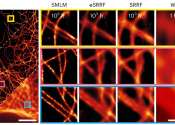Researchers turn cell phones into fluorescent microscopes
(PhysOrg.com) -- Researchers at the University of California, Berkeley, are proving that a camera phone can capture far more than photos of people or pets at play. They have now developed a cell phone microscope, or CellScope, ...







